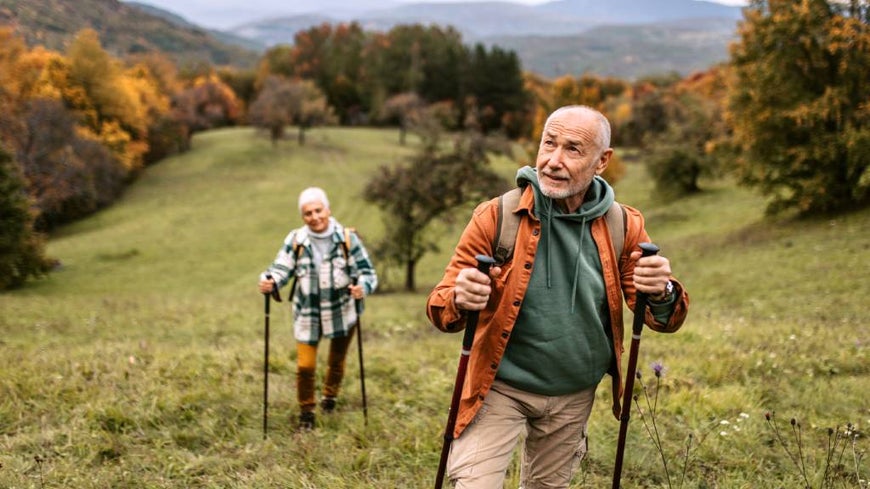How to get into rucking for fitness

Written by Rachel Smith for Seniors Health Insurance.
You’ve tried running and may have ended up injured. You’d rather do anything but lift weights in the gym. But you’re keen to stay fit and tone up – so what’s next? Well, rucking: the deceptively simple, full-body workout that involves walking at pace, with a weighted backpack or vest. It’s a no-brainer for James ‘Chief’ Brabon of Transformation Coach who ‘rucked’ his way through a military career and now incorporates it into workouts for his clients, who have included 50-something stars such as Rodger Corser, Manu Feildel, Larry Emdur, Pete Murray and Kylie Gillies.
Chief acknowledges it can be hard to get a workout in when you’re over 50 and battling knee or back issues. But he knows how to work around it. “From 21 onwards, we’re losing lean muscle mass every year and we want to work our muscles to fight back against that loss,” he explains. “Walking at pace or rucking, is a great way to do it, especially when you add resistance in the form of a weighted vest or backpack.”
The biggest benefit Chief has seen in clients who adopt rucking as part of their workout is increased cardiovascular fitness and a drop in body fat. “Adding additional weight or resistance to a movement requires greater muscle retrieval, so your glutes, your legs, your calves and your mid-section will all be working harder.” Rucking is also a great way to get more bang for your buck. “A shorter workout can count more if you add that additional weight. You can ruck while marching up and down a staircase, or you can ruck on the beach, which can be incredibly intense because it’s not just your body weight sinking into that soft sand, it’s the additional weight you’re carrying.”
You’ll see changes in the mirror after a month or two, he adds. “Do it properly and often enough and you’ll see increased tone and reduced body fat because you’re getting your heart rate up, burning more calories and increasing your lean muscle mass.” Running can fast-track some of us to weight loss, but it’s not for everyone – including Chief. “After years of running ultra-marathons, I had a bad knee injury and I found going back to speed marching, or rucking, allowed me to completely recover my joints but also get that cardiovascular benefit.”

Is running better than rucking?
So can you ditch running for rucking? “Absolutely. It has many of the same cardio benefits but is low impact, specifically on your lower body and spine – and is easier on your joints. Those two things combined means less injuries.”
It’s also a workout with a low barrier to entry – you can get started with a supportive pair of trainers and a good quality backpack. “A pack with adjustable straps is ideal so you can pull the pack high onto your back, and a strap that runs across your chest would also be great,” says Chief.
If you want to try a weighted vest, look for an adjustable one – not one full of ball bearings or sand that you can’t take weight out of or add to. “You want one that’s essentially empty, with pockets on it that you can add weights to,” he says. “So you might start rucking with no weight in the vest, and add one kilo weights as you get stronger. My advice would be to get weight high on your back first before you start with anything on your lower back, as that might be detrimental.”

Managing risk
You’ll want to run any new workout by your GP, but if you have an okay level of fitness and don’t suffer from any obvious issues, you can just give it a crack, says Chief. “Rucking is just starting with walking, building up that pace, then adding some additional weight step by step, so there should be no adverse effect – but make sure you do a good joint mobility warm-up before you work out.”
If you start rucking and get joint pain, take a look at your footwear. “If you’ve suffered ankle pain in the past, you might need to invest in a trainer that’s a bit more like a boot that comes over the ankle,” he says. “Nike and Under Armour do bootstyle trainers, which offer extra support.”
Chief offers some other tips for getting started and seeing results:
1. Walk at pace every day.
“That means at a pace where you almost want to break into a jog. Do that for 30-45 minutes every day, no weight to start with.”
2. Add weight with a pack or vest.
“If your speed marching is getting easier, start adding resistance every second day – such as a backpack with a bit of weight in it, or a weighted vest. Slowly increase as you get stronger.”
3. Challenge yourself.
“If you’re rucking with a pack, sand balls can be good – they’re like a kettlebell filled with sand. Stop in a park, give your lower body a rest and use the sand balls to do some upper body exercises.”
4. Ruck with a mate.
“Rucking with a group or friends is a fantastic way to get a good workout in – you can do it safely, with support and there’s motivation to keep your speed up.”
23 Apr 2024